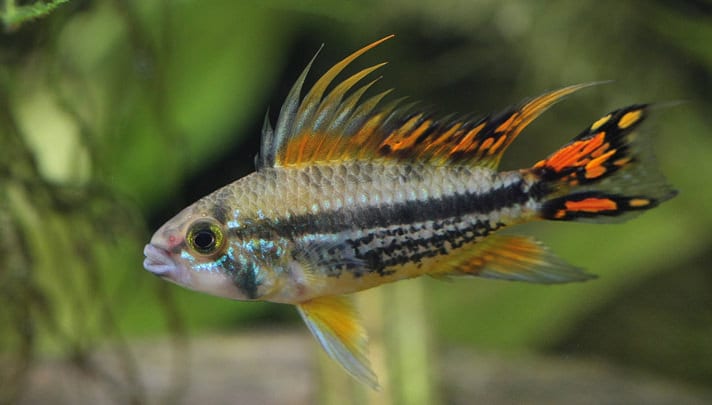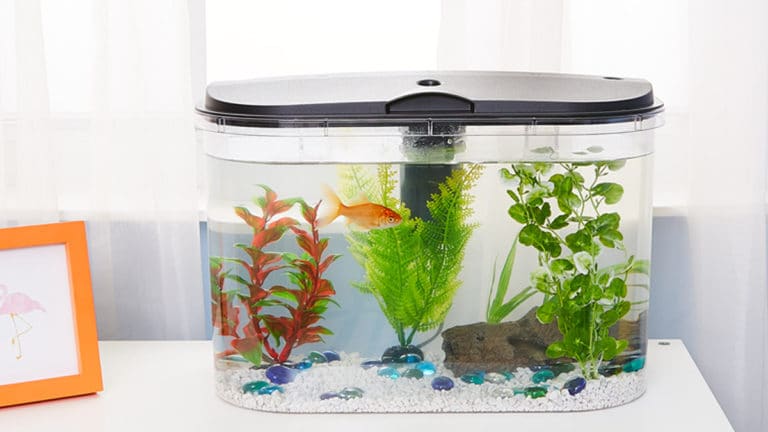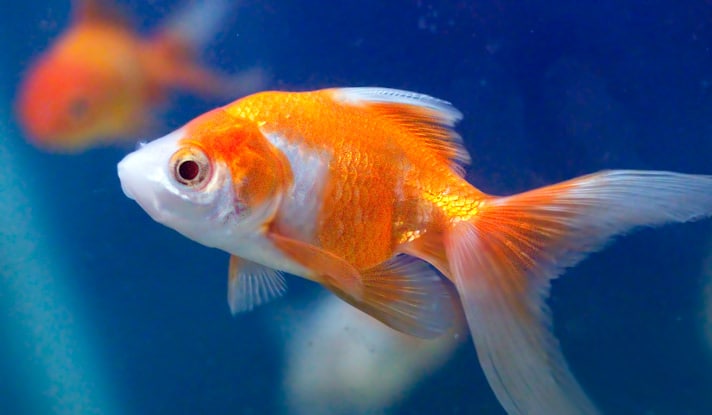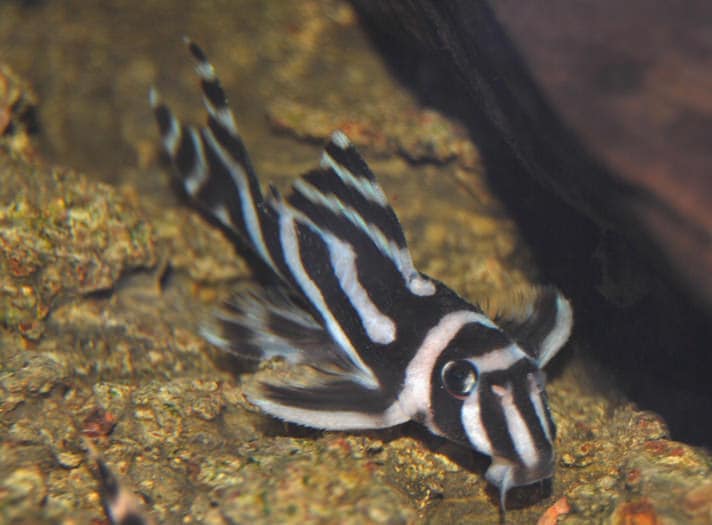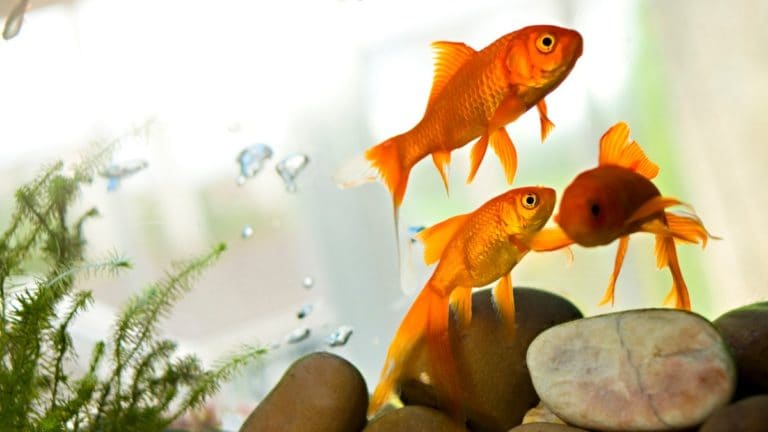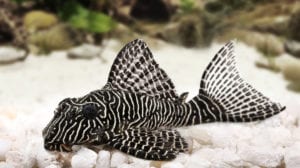My experience with these fish goes back a long way — that is, to a long time ago — and provided me with the initial push to work with full-sized eartheaters rather than the dwarf variety. Why? Apistos are not for lazy aquarists. They have their own set of requirements and usually demand near constant attention for complete success.
The most successful apistophile I ever met fed his fish live foods and changed at least 10 percent of the water in every aquarium, every day! This was, perhaps, excessive, but the fish were gorgeous and he bred everything. He was employed in medical research growing cancer cells in culture — beasts that required much more daily care than even his apistos received.
Of course, individual species vary in difficulty, but some general guidelines should be noted. In fact, we’ve already specified most of them in a previous article on the smiling acaras of the genus Laetacara.
So, for the sake of new readers just joining this series, or old readers with faulty long-term memories (after all, it was August 1992), let’s review some of the basics. I also recommend two other basic husbandry articles by Stankevitch (1987) and DeAngelo (1991), and, of course, the earlier classic by Loiselle (1979). Remember, the pointers below are chiefly mine and not necessarily the majority opinion. If it works for you, don’t change it!
Hailing generally as they do from tropical South America, these fish should be maintained in warm (78 to 86 degrees Fahrenheit), clean water. In fact, many of the Apistogramma species come from soft, acid water (pH 6 to 7), and if your water is liquid “rock,” you are going to have to do something about it. One approach to consider is mixing it with softened, or distilled, water. Cardwell (1991) describes his synthesis of Amazon blackwater using distilled drinking water, a half teaspoon of salt per gallon and a handful of peat moss or Tetra blackwater tonic, to bring the pH down to 6.8.
This is fine for a small aquarium or two, but if you are really going to get into apistos, you should consider a reverse osmosis (RO) system. These units take tap water and “distill” it by pushing it through an extremely fine membrane.
Because apistos are small and can be maintained in smaller aquariums, the volume of water you need to produce is not really prohibitive. You can use an aquarium holding 10 to 15 gallons, although I personally wouldn’t recommend anything less than 20 gallons — and it matters which species of apisto you are working with. Small fish don’t necessarily mean small aquariums (see below and Stankevitch 1987).
Nonetheless, these small sizes mean that you can get away nicely with one of the smaller RO units (e.g., 10 gallons a day) unless fish room expansion is on your agenda.
Reverse osmosis units are, however, fairly expensive. As long as you’re spending a few hundred dollars for a small unit, why not spend a hundred more for a really high-capacity version?
Do not put your fish in straight distilled water with no hardness. Either add salt to taste (a conductivity meter is useful here) or mix it with your own tap water until the desired hardness is reached. What hardness? Well, as I said earlier, apistos live in black-, white- and clearwater habitats, so there is no blanket recommendation. If I were to err, it would be on the side of “barely detectable” hardness.
Luckily, collection data — including hardness and conductivity — are given on a nearly species-by-species basis in the Linke and Staeck (1985/1989 translations) book. In the general introduction, they provide a complete analysis of black-, white- and clearwaters from Peru. The relevant, though partial data, is as follows: blackwater — pH 6.0, conductivity 17 microSiemens, general hardness 0.12 DH, carbonate hardness 0 DH; clearwater — pH 7.2, conductivity 142 microSiemens, general hardness 4.9 DH, carbonate hardness 4.7 DH; whitewater — pH 7.1, conductivity 154 microSiemens, general hardness 2.9 DH, carbonate hardness 3.9 DH.
As you can see, apistos don’t all live in incredibly soft, acid water. But, in the absence of locality data coupled with water analysis, soft and acid is the best bet. In fact, A. nijsseni were collected from a blackwater creek in Peru whose water measured pH 5.4, with no detectable hardness (Cardwell 1991)!
Either way, I’m a firm believer in peat as an essential additive to the water for these freshwater fish. Peat in a filter box will slowly leach tannins into the water, giving it a brown tint and making most Amazonian cichlid fish happy and randy. Some of the leachable peat compounds are analogous to natural reproductive pheromones. Peat will also chelate (pull out) harmful materials from your water.
You can obtain peat either by the bale or as “Jiffy Peat” pellets. Make sure it is not treated with fungicide (it should say on the package). Boil the peat, pour off the brown, evil-looking liquor, squeeze the rest of it out, and then put a handful of the preboiled peat in a box filter (using the “foot” of a boiled stocking as a sack will help keep it neat). This is an old killifish trick (and I’m an old, reformed killifish enthusiast) and it works well for apistos as well. Sound like too much trouble? Then try commercially prepared peat extracts (e.g., Tetra’s Blackwater Tonic).
Above all, the water should be kept clean — sponge filters and regular (biweekly) partial (20 to 35 percent) water changes should keep them happy. Too much filtration, in the case of apistos, is defined only as too much “water movement.” The solution to maintaining clean water in small aquariumis to have multiple small filters, not huge power or canister filters. You don’t want to buffet the fish around.
Chemical exchange resins, such as Poly Filter or Chemi-Pure, can also be helpful in maintaining low levels of nitrogen wastes in your aquarium. Be aware, however, that these will remove the peat tannins as well.
In terms of water parameters for breeding, in the wild it is often the rains of the rainy season that trigger spawning. In the home aquarium, a sudden drop in water hardness (a simple water change will do) or a change in temperature often stimulate ripe fish to spawn.
These fish are quite shy and retiring and require a planted aquarium with plenty of hiding places (e.g., driftwood, PVC tubing, flowerpots and so on). A fine gravel substrate is recommended.
Apistos seem uncomfortable over bare bottoms and they seem to enjoy digging. Stankevitch (1987) recommends black or dark gravel as best.
Plants should include both anchored and floating varieties, the latter to cut down on illumination, which should make these fish feel more at home. Recommended plants? Well, I have a black thumb when it comes to plants, but Java fern (Microsorium pteropus) and Java moss (Vesicularia dubyana) are two good choices for the bottom — perhaps anchored to the driftwood — because they get along well at reduced light intensities. I would use that old standby water sprite (Ceratopterus thalictoides) or even duckweed (Lemna spp.) or Salvinia (Salvinia spp.) for floating plants at the surface. There are many other horticultural solutions, but the ones noted above suit my black thumb (and the fish!) quite well, thank you.
Even with a variety of hiding places and a lush garden, these fish may still feel quite intimidated. Get them some happy dither fish in the form of peacefully schooling tetras. Tetras, at the bottom rung of the fish neuronal ladder (along with African cichlid fish), are beautiful, but exceedingly unintelligent — they will swim back and forth with nary a thought or a care!
The somewhat more discriminating apistos will see them swimming about and think “Safe!,” and come out of their hiding places. It is an apparent paradox, but, the more hiding places they have, the more you will see of the fish!
As regards to fish food, forget an exclusive diet of commercially prepared flakes! In fact, forget prepared foods at all (well, maybe some of the hardier apistos, like A. steindachneri or captive-bred juveniles might get by).
If you must use these foods, alternate them regularly with high-quality frozen and live foods. DeAngelo (1991) recommends ignoring both Tubifex and blackworms for apistos, and I concur: The cleanliness (usually lack thereof) of these worms is of special concern when keeping apistos. I know many of you use them, but there are several excellent alternatives that do not present the same chance of problems. These include live or frozen glassworms (Chaoborus larvae) and frozen bloodworms (chironimid larvae), not to mention live or frozen Daphnia and mosquito larvae.
I personally avoid frozen brine shrimp in apisto aquariums (and most everywhere else). It can really foul up an aquarium and is of doubtful nutritional value, in my opinion. Live brine shrimp are another matter, if fed sparingly.
One live food that is easy and plentiful and often overlooked is newly hatched brine shrimp. That’s right, baby Artemia for adult fish! In this case, the adults are small enough to apparently not mind catching nauplii, and they derive considerable nutritive value from them. Give it a try! However, remember that these are small cichlid fish with relatively small appetites — don’t blast them with lots of food that will ultimately be uneaten and ruin the water quality they need.
The perfect apisto aquarium, as described by Al DeAngelo (1991), is a 40-gallon-long aquarium with a wet/dry filtration system, live plants over fine gravel, a covering of giant duckweed and a large school of mixed pencilfish, neon or cardinal tetras, marbled hatchetfish at the surface and several pairs of Apistogramma species residing in the bottom layer. I agree.
Although pairs can be successfully housed in 10- or even 5-gallon aquariums, bigger is indeed better here. This kind of setup is not only beautiful, but its volume helps maintain the extremely critical water quality and enables the aquarist to witness apisto social behavior in all its glory. If you are thinking about getting into apistos, such a community aquarium is probably a good starting point.
Spawning Apistos
As is true for most cichlid fish, spawning pairs are best gotten by purchasing a small group of young individuals and then raising them together. If juveniles are available, choose large ones and small ones — females grow slower than males and reach a smaller adult size, often half that of their male counterparts. Apistos are sexually dimorphic beyond the size dimorphism. Males typically are the more colorful of the two.
For species in which the tails become spade-shaped (e.g., A. agassizii, A. gephyra) or lyrate (e.g., A. cacatuoides, A. bitaeniata), the female’s tail will remain rounded. Similarly, dorsal fin plumage (e.g., A. cacatuoides, A. bitaeniata, A. trifasciata) is not echoed in females, and in general, the unpaired fins are more prominent in males than in females.
In spawning or brood-tending coloration, there is no mistaking a female apisto. In fact, most spawnings are discovered this way. The females of nearly all species turn bright yellow-gold and express a black mid-lateral blotch, black striping through the eyes and black edges to their paired ventral fins.
Sometimes, it is possible to mistakenly choose a cryptic male as a potential female partner from an aquarium of adults or sub-adults. Their coloration is halfway between that of a female and a very young male (Makin 1991). Often, so-called “sneaker” males remain female-like in coloration, thereby protecting themselves from the aggression of more dominant, often territorial males.
These sneaker males do something else — they sometimes enter the breeding cave dressed like females, fooling the resident male, and fertilize the eggs of the female before the first male has a chance to spray his milt. They also metamorphose into beautiful, normally colored males if the dominant male is removed. This is perhaps one of the best reasons for suggesting maintaining groups of apistos in barer aquariums rather than single pairs in smaller aquariums. I direct you to the excellent article by Hal Makin (1991) about this phenomenon in the aquarium, and we will have more to say about it below.
Another reason for maintaining groups of apistos is that many of them are harem polygynists in the aquarium if given half a chance (that is, if multiple females are present). This has been the experience of many apistophiles, including myself. There are a number of species that harem spawn, including Apistogramma agassizii, Apistogramma bitaeniata and Apistogramma cacatuoides.
Burchard (1966) has studied the phenomenon from a scientific perspective and his paper on the subject makes for interesting reading. In fact, his work is the best reason for maintaining apistos in large communities. Burchard describes the behavior of a large community of A. trifasciata in various-sized aquariums up to 200 gallons.
Males stake out large territories, as much as 3 feet across in diameter, centered around a cave or cavity. Not all males hold territories, and it is only the largest, most dominant that can. It is for this reason, then, that Burchard believes the profound sexual dimorphism has occurred, with selection for size and aggression using optical markers (i.e., aspects of coloration and finnage) as part of the ritualized display that establishes dominance.
Ripe females approach males and follow them to the cavity, where they spawn. If enough cavities are available in the territory, the male will spawn with multiple females. Burchard reports that one male can spawn with at least three females in a single day and successfully fertilize at least two clutches of eggs virtually simultaneously by visiting the cavities, in turn, at intervals of a few minutes! Usually, apisto aquariums are much smaller than the 3 feet diameter of the typical A. trifasciata territory, so it’s no wonder harem polygyny will take place given multiple females and multiple spawning sites.
In the wild, these “cavities,” or cave spawning sites, can be a hole in a submerged log or underneath leaf litter. On our trip to Peru in 1987, AFI columnist Chuck Davis poured a female apisto and her fry from a rolled up leaf he had netted out! In the aquarium, appropriate spawning sites may include overturned flowerpots with a notch knocked from the rim, hollowed out coconut shells, a pile of rocks, or anything that smacks of “cave.” Again, if you are keeping multiple females, add several caves.
Females will claim individual territories centering around the hidden egg site within the male’s larger territory. “Sneaker” males — along with subordinate, non-territorial females — live within, or on, the fringes of the dominant male’s territory: All try to appear inconspicuous and submissive and avoid eliciting aggression (Makin 1991).
Apparently, ripe females will allow any male access to the cave if they can get past the territorial male and behave “male-like.” The sneaker male is able to do this when the territorial male is engaged in driving off other fishes. As Makin (1991) put it, “In comedy, war and romance, timing is everything.”
Having spawned, the female becomes a dervish. With her gold color ablaze, she becomes “super” mom and will often not tolerate the presence of the male. In a large aquarium, this is no problem — he simply swims away. In a small aquarium — big problem!
The female takes exceptional care of her brood as they become free-swimming and swarm to forage. Their “broodiness” is so diligent that often female apistos, even non-brooding ones, will adopt clusters of Tubifex, swarms of Daphnia or other objects somewhat resembling young fish (Burchard 1966).
Newly free-swimming fry are usually capable of eating newly hatched brine shrimp and/or microworms, but liquid fry foods or encapsulated rotifers (OSI’s APR product) may be useful for the first few days for some species. Females abandon their broods after about three weeks and are ready to spawn — with good feeding — shortly thereafter. For details on the spawning of particular Apistogramma species, I recommend the Linke and Staeck (1989) translation that I mentioned previously.
Conclusion
It is with some regret that this article is brought to a close. I have avoided a direct discussion of individual species, instead opting for some broad generalities about members of this genus. So many apistos, so little time!
Instead, I direct you to one of the many books on dwarf cichlid fish for additional information on the requirements and idiosyncrasies of individual species. I hope, however, that I have convinced you that the best way to keep apistos, the route with the greatest payoff in terms of observing the social structure and interactions of South American cichlid fish, is the large community setup.
Apistos may be small, but they are still cichlids — with a vengeance! Their behavioral repertory is every bit as complicated as that of a large oscar — perhaps even more so — but they require less space to do it in. This increases the probability that what you are seeing in the aquarium environment is a true mirror of their wild behavior and not simply an artifact of reduced space.
I believe that the behavior in a large community aquarium is accurate and that dwarf cichlid fish of the genus Apistogramma provide an incredible window on cichlid behavior in the raw. Next time we will review the remaining dwarf cichlid fish, all relatives of the apistos with similar habits and requirements in the aquarium. We will look at the rams, the checkerboards and a few other oddball dwarves.
Posted by: Chewy Editorial
Feature Image: Via Dornenwolf/Flickr
Share:
